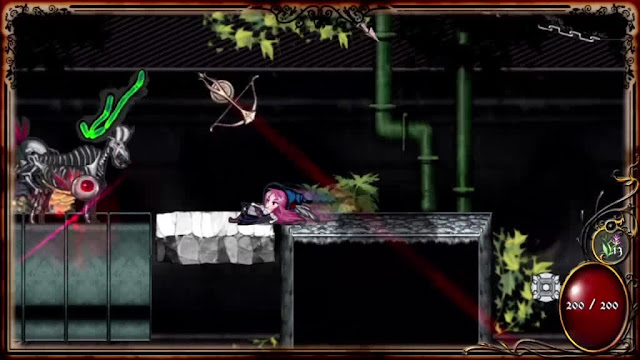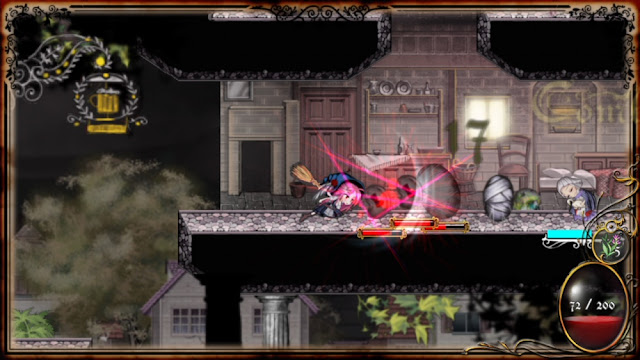Wicce is, unfortunately, not good. It’s got a lot of things going for it at first – a pleasing, hand-drawn art style, engrossing monster design and a captivating dark fairytale aesthetic. But its main problem is its strict adherence to being a standard platformer/brawler, partaking in the most menial parts of each genre without any of the reward. The story is also hamstrung by a decision to forego words altogether, opting instead for immersion-breaking symbols and gestures that merely hint at a narrative rather than developing its characters. The result is an experience that feels tiresome to play through; it’s something masquerading as a good game, but never paying off on the promise of action or excitement.
The game comes from Korean developer Alpharatz, and is a port of a 2016 Steam release. The port seems to be the stem of many of Wicce’s problems – compared to the PC version, the Switch game is woefully zoomed-in, even in docked mode. The upside is that players can appreciate the detail of Wicce’s hand-drawn art assets, but the downside is that many levels have not been adapted to accommodate for the smaller screen. This means that you’ll be doing frequent leaps of faith over instant-death pits, in a game with only three lives before you need to start the chapter anew.
Wicce has one little platforming gimmick which sets it apart – the protagonist is a witch, who can ride a broomstick to zoom across gaps and latch onto certain environmental objects. By default, hitting A and B at the same time will zoom horizontally forward, unless there’s a grabbable object nearby, at which point the input will send the player towards that object. This mechanic never felt consistent to me – sometimes my character would zoom diagonally downwards and fall into a pit when I’d intended for her to go straight. The cramped screen space also ensures that you can’t see your destination if you choose to zoom for its maximum distance.
The game is short, with a cinematic scope rather than a level-select process. The level design feels a little like the way Ori and the Blind Forest handles it – you play through a sequence of platforming stages and arrive at a boss which you fight for a while before it runs away, leading you through some more platforming until you get the chance to kill the boss once and for all. This becomes problematic when you consider the game’s health and continues system – you get three game-overs and you need to start the entire chapter over again: if you’ve beaten the midway boss and then fall into a pit, you’re back to square one.
The bosses themselves are at least pretty impressive. They’re designed to be huge, with vast attack patterns which cover the whole screen. The player doesn’t really get agile mobility options like in Ori or Celeste, and the band-aid solution seems to be instead a large health pool and healing items, that ensures players can take a decent beating. The bosses themselves are defeated in interesting ways, with brief periods of vulnerability that award risky play.
The same can’t be said for the regular stage enemies though, which clump together and stand there waiting to get killed. The worst is what looks like a stationary pair of lungs, which just sits motionless until it’s attacked enough times. The problem is that these stationary enemies tend to get placed at the edge of difficult jumps, so it becomes a matter of hitting the attack button a few obligatory times before you get the privilege of landing.
Stage enemies drop gold, which can be used to buy cosmetic items, but there’s no penalty for just skipping them. In fact, skipping enemies is the suggested solution, since you’ve only got three lives and a limited pool of health recovery items, and it’s not worth risking a drop of your blood before you face off against the chapter’s boss. There are also civilians which can be rescued throughout the levels, but they can be hurt by the player’s attack, and they just so happen to be placed near clumps of enemies.
So put it all together, and you get platforming which doesn’t feel fair, instant death pits that require memorisation, beat-em-up combat against enemies which show no resistance and give no reward, only for the chance to fight a decent boss battle while quivering because losing means doing the whole platforming gauntlet all over again. At times I wondered to myself if all these mechanics were created with tedium in mind – the game is hard, but the difficulty comes from outright hostile design choices rather than any satisfying challenge. From what I can see of the PC version though, it’s a much more balanced experience, with more telegraphed enemy placements and even an option to look further in each direction – which seems to be absent in the Switch port. If the narrative and graphics pique your interest, I’d recommend going for the PC version of Wicce instead, and staying well away from the iteration on the Switch.
– Harvard L.










